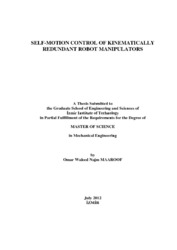Please use this identifier to cite or link to this item:
https://hdl.handle.net/11147/3493Full metadata record
| DC Field | Value | Language |
|---|---|---|
| dc.contributor.advisor | Dede, Mehmet İsmet Can | en |
| dc.contributor.author | Maaroof, Omar Waleed Najm | - |
| dc.date.accessioned | 2014-07-22T13:51:40Z | - |
| dc.date.available | 2014-07-22T13:51:40Z | - |
| dc.date.issued | 2012 | en |
| dc.identifier.uri | http://hdl.handle.net/11147/3493 | - |
| dc.description | Thesis (Master)--Izmir Institute of Technology, Mechanical Engineering, Izmir, 2012 | en |
| dc.description | Includes bibliographical references (leaves: 88-92) | en |
| dc.description | Text in English; Abstract: Turkish and English | en |
| dc.description | xvi,92 leaves | en |
| dc.description.abstract | Redundancy in general provides space for optimization in robotics. Redundancy can be defined as sensor/actuator redundancy or kinematic redundancy. The redundancy considered in this thesis is the kinematic redundancy where the total degrees-of-freedom of the robot is more than the total degrees-of-freedom required for the task to be executed. This provides infinite number of solutions to perform the same task, thus, various subtasks can be carried out during the main-task execution. This work utilizes the property of self-motion for kinematically redundant robot manipulators by designing the general subtask controller that controls the joint motion in the null-space of the Jacobian matrix. The general subtask controller is implemented for various subtasks in this thesis. Minimizing the total joint motion, singularity avoidance, posture optimization for static impact force objectives, which include maximizing/minimizing the static impact force magnitude, and static and moving obstacle (point to point) collision avoidance are the subtasks considered in this thesis. New control architecture is developed to accomplish both the main-task and the previously mentioned subtasks. In this architecture, objective function for each subtask is formed. Then, the gradient of the objective function is used in the subtask controller to execute subtask objective while tracking a given end-effector trajectory. The tracking of the end-effector is called main-task. The SCHUNK LWA4-Arm robot arm with seven degrees-of-freedom is developed first in SolidWorks® as a computer-aided-design (CAD) model. Then, the CAD model is converted to MATLAB® Simulink model using SimMechanics CAD translator to be used in the simulation tests of the controller. Kinematics and dynamics equations of the robot are derived to be used in the controllers. Simulation test results are presented for the kinematically redundant robot manipulator operating in 3D space carrying out the main-task and the selected subtasks for this study. The simulation test results indicate that the developed controller’s performance is successful for all the main-task and subtask objectives. | en |
| dc.language.iso | en | en_US |
| dc.publisher | Izmir Institute of Technology | en |
| dc.rights | info:eu-repo/semantics/openAccess | en_US |
| dc.subject.lcsh | Robots--Dynamics | en |
| dc.subject.lcsh | Manipulators (Mechanism)--Automatic control | en |
| dc.subject.lcsh | Robots--Kinematics | en |
| dc.subject.lcsh | Robots--Control systems | en |
| dc.title | Self-motion control of kinematically redundant robot manipulators | en_US |
| dc.type | Master Thesis | en_US |
| dc.institutionauthor | Maaroof, Omar Waleed Najm | - |
| dc.department | Thesis (Master)--İzmir Institute of Technology, Mechanical Engineering | en_US |
| dc.relation.publicationcategory | Tez | en_US |
| item.fulltext | With Fulltext | - |
| item.grantfulltext | open | - |
| item.languageiso639-1 | en | - |
| item.openairecristype | http://purl.org/coar/resource_type/c_18cf | - |
| item.cerifentitytype | Publications | - |
| item.openairetype | Master Thesis | - |
| Appears in Collections: | Master Degree / Yüksek Lisans Tezleri | |
Files in This Item:
| File | Description | Size | Format | |
|---|---|---|---|---|
| T001037.pdf | MasterThesis | 2.49 MB | Adobe PDF |  View/Open |
CORE Recommender
Page view(s)
270
checked on Nov 18, 2024
Download(s)
144
checked on Nov 18, 2024
Google ScholarTM
Check
Items in GCRIS Repository are protected by copyright, with all rights reserved, unless otherwise indicated.